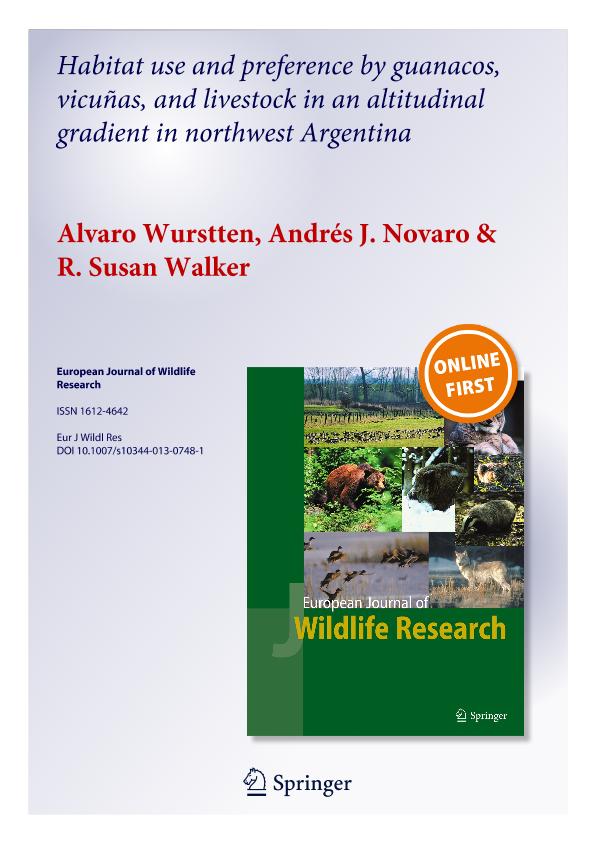Mostrar el registro sencillo del ítem
dc.contributor.author
Wurstten, Alvaro

dc.contributor.author
Novaro, Andres Jose

dc.contributor.author
Walker, R. Susan
dc.date.available
2016-07-29T16:24:40Z
dc.date.issued
2013-06
dc.identifier.citation
Wurstten, Alvaro; Novaro, Andres Jose; Walker, R. Susan; Habitat use and preference by guanacos, vicuñas and livestock in an altitudinal gradient in northwest Argentina; Springer; European Journal Of Wildlife Research; 60; 1; 6-2013; 35-43
dc.identifier.issn
1612-4642
dc.identifier.uri
http://hdl.handle.net/11336/6807
dc.description.abstract
Distribution of ungulates is regulated by natural factors, such as presence of other species, climate, and habitat variability, as well as human activities, including livestock grazing and mining. Understanding the spatial dynamics of landscape use can help solve problems of access to key resources by native herbivores. Laguna Brava Reserve is a protected area of Argentina where the two wild South American camelids, guanacos and vicuñas, coexist with cattle, mules, horses, and goats. Information about the effects of livestock and mining activities, which are widespread throughout the region, on wild camelids is scarce. We used variable-width transects to determine the distribution of guanacos, vicuñas, equids, and cattle in relation to five habitat types defined according to vegetation and topography in the reserve. We carried out a correspondence analysis between the proportion of groups observed in and the proportion of area occupied by each habitat, and a χ2 goodness of fit test to establish if camelids and livestock selected a particular habitat type. Vicuñas were associated with grasslands at high altitudes while guanacos and livestock were associated with shrublands at lower elevations. This coevolutionary segregation between guanacos and vicuñas possibly reduced competition between the two species. Competition between camelids and livestock is probably low because of the low density of livestock. Vegas were preferred by all species year round but used more intensively in summer. In order to conserve the wild camelids of the region, governments must implement measures to conserve the critical habitat provided by the vegas.
dc.format
application/pdf
dc.language.iso
eng
dc.publisher
Springer

dc.rights
info:eu-repo/semantics/openAccess
dc.rights.uri
https://creativecommons.org/licenses/by-nc-sa/2.5/ar/
dc.subject
Habitat Utilization
dc.subject
Guanacos
dc.subject
Vicuñas
dc.subject
Livestock
dc.subject
Competition
dc.subject
Mining
dc.subject.classification
Conservación de la Biodiversidad

dc.subject.classification
Ciencias Biológicas

dc.subject.classification
CIENCIAS NATURALES Y EXACTAS

dc.title
Habitat use and preference by guanacos, vicuñas and livestock in an altitudinal gradient in northwest Argentina
dc.type
info:eu-repo/semantics/article
dc.type
info:ar-repo/semantics/artículo
dc.type
info:eu-repo/semantics/publishedVersion
dc.date.updated
2016-07-28T18:34:17Z
dc.journal.volume
60
dc.journal.number
1
dc.journal.pagination
35-43
dc.journal.pais
Alemania

dc.journal.ciudad
Berlin
dc.description.fil
Fil: Wurstten, Alvaro. Consejo Nacional de Investigaciones Científicas y Técnicas. Centro Científico Tecnológico Patagonia Norte. Instituto de Investigación En Biodiversidad y Medioambiente; Argentina
dc.description.fil
Fil: Novaro, Andres Jose. Consejo Nacional de Investigaciones Científicas y Técnicas. Centro Científico Tecnológico Patagonia Norte. Instituto de Investigación en Biodiversidad y Medioambiente; Argentina. Wildlife Conservation Society; Estados Unidos
dc.description.fil
Fil: Walker, R. Susan. Wildlife Conservation Society; Estados Unidos
dc.journal.title
European Journal Of Wildlife Research

dc.relation.alternativeid
info:eu-repo/semantics/altIdentifier/url/http://link.springer.com/article/10.1007/s10344-013-0748-1
dc.relation.alternativeid
info:eu-repo/semantics/altIdentifier/doi/10.1007/s10344-013-0748-1
dc.relation.alternativeid
info:eu-repo/semantics/altIdentifier/doi/http://dx.doi.org/10.1007/s10344-013-0748-1
Archivos asociados
